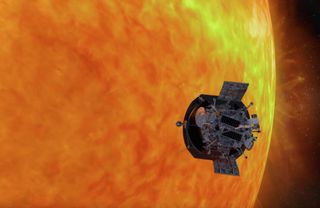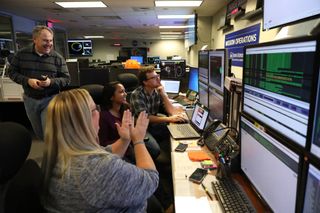NASA's Sun-Kissing Solar Probe Survives 1st Flyby of Our Star
NASA's Parker Solar Probe has survived its first trial by fire.
The spacecraft zoomed within 15 million miles (24 million kilometers) of the sun on Monday (Nov. 5) — far closer than any mission had ever gotten before. And on Wednesday afternoon (Nov. 7), the probe phoned home, telling its controllers that it's in good health and continuing to collect science data.
"Parker Solar Probe was designed to take care of itself and its precious payload during this close approach, with no control from us on Earth — and now we know it succeeded," Thomas Zurbuchen, associate administrator of NASA's Science Mission Directorate at agency headquarters in Washington, D.C., said in a statement. [The Parker Solar Probe's Mission to the Sun in Pictures]

"Parker is the culmination of six decades of scientific progress," Zurbuchen added. "Now, we have realized humanity's first close visit to our star, which will have implications not just here on Earth, but for a deeper understanding of our universe."
The probe also set a speed record during its first solar encounter, which technically ran from Oct. 31 through Monday. At closest approach, the spacecraft topped out at 213,200 mph (343,112 km/h) relative to the sun, NASA officials said.

The German-American Helios 2 mission had held both the speed and close-approach records. In April 1976, that probe reached 153,454 mph (246,960 km/h) and got within 26.55 million miles (42.73 million km) of the sun.
The Parker Solar Probe will break both of its new records many times over the next seven years. The spacecraft will make 23 additional solar flybys during this span, getting closer and closer to our star.
Get the Space.com Newsletter
Breaking space news, the latest updates on rocket launches, skywatching events and more!
The final close approach, in late 2025, will take the Parker Solar Probe to within just 3.83 million miles (6.16 million km) of the sun's surface. During that dramatic flyby, the sun's gravity will accelerate the spacecraft to around 430,000 mph (690,000 km/h), NASA officials have said.
The $1.5 billion Parker Solar Probe mission launched on Aug. 12, tasked with helping scientists better understand the sun's structure, composition and activity. The observations the spacecraft makes during its flybys should help solve two longstanding solar puzzles, mission team members have said — why the sun's outer atmosphere, or corona, is so much hotter than the surface, and how the flow of charged particles known as the solar wind gets accelerated to such high speeds.
Mike Wall's book about the search for alien life, "Out There,"will be published on Nov. 13 by Grand Central Publishing. Follow him on Twitter @michaeldwall. Follow us @Spacedotcom or Facebook. Originally published on Space.com.
Join our Space Forums to keep talking space on the latest missions, night sky and more! And if you have a news tip, correction or comment, let us know at: community@space.com.

Michael Wall is a Senior Space Writer with Space.com and joined the team in 2010. He primarily covers exoplanets, spaceflight and military space, but has been known to dabble in the space art beat. His book about the search for alien life, "Out There," was published on Nov. 13, 2018. Before becoming a science writer, Michael worked as a herpetologist and wildlife biologist. He has a Ph.D. in evolutionary biology from the University of Sydney, Australia, a bachelor's degree from the University of Arizona, and a graduate certificate in science writing from the University of California, Santa Cruz. To find out what his latest project is, you can follow Michael on Twitter.
